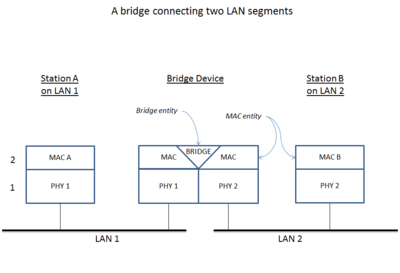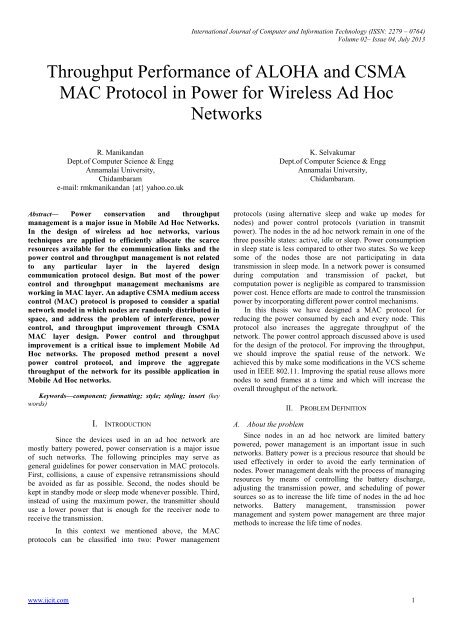MAC/PHY Co-Design of CSMA Wireless Networks Using Software Radios. We leverage the reconfigurability of software radios to design smart signal processing algorithms that meet the challenge of making PHY capabilities usable by the MAC layer. With the approach of MAC/PHY co-design, we have revisited the primitive operations of CSMA (collision. Jul 15, 2013 A multichannel CSMA MAC protocol with receiver-based channel selection for multihop wireless networks. In: Proceedings of the international conference on computer communications and networks, Las Vegas, NV, USA; 2001. Tractable network models, we profile the sufficient condition when DAC improves the performance of existing routing protocols. The rest of this paper is organized as follows. 2 discusses the work related to wireless relay networks. 3 describes the design and implementation of the DAC PHY. The DAC-based MAC and routing protocols. Carrier Sense Multiple Access with Collision Detection (CSMA/CD) – In this method, a station monitors the medium after it sends a frame to see if the transmission was successful. If successful, the station is finished, if not, the frame is sent again.

This example shows how to simulate the IEEE® 802.15.4™ asynchronous CSMA MAC [ 1 ] using the Communications Toolbox™ Library for the ZigBee® Protocol.
Background
The IEEE 802.15.4 standard specifies the MAC and PHY layers of Low-Rate Wireless Personal Area Networks (LR-WPANs) [ 1 ]. The IEEE 802.15.4 MAC and PHY layers provide the basis of other higher-layer standards, such as ZigBee, WirelessHart®, 6LoWPAN and MiWi. Such standards find application in home automation and sensor networking and are highly relevant to the Internet of Things (IoT) trend.
The IEEE 802.15.4 MAC [ 1 ] specifies two-basic MAC modes: (i) non-beacon-enabled, and (ii) beacon-enabled MAC. The non-beacon enabled MAC is an asynchronous CSMA (Carrier-sense Multiple Access) MAC, which is very similar to the IEEE 802.11 MAC. The beacon-enabled MAC allows two different MAC periods: (i) a synchronized-CSMA MAC period, and (ii) a time-slotted, contention-free MAC period. This example provides an extensive simulation of the non-beacon-enabled, asynchronous, CSMA-based IEEE 802.15.4 MAC.
Network Setup
An IEEE 802.15.4 PAN (personal area network) is set up by a standard process between end devices and PAN coordinators. First, devices that would like to join a network perform either active or passive scanning. Active scanning means that a device first transmits a Beacon Request and later on it performs passive scanning. Passive scanning means that the device sniffs to collect beacon frames from PAN coordinators (who may have received their Beacon Request in the case of active scanning). Upon the collection of beacons during passive scanning, the end device chooses the PAN with which it would like to associate. Then it transmits an Association Request to the coordinator of this PAN and the coordinator acknowledges it.
In contrast to IEEE 802.11, the coordinator does not follow the acknowledgment of an Association Request with an immediate transmission of an Association Response. Instead, the IEEE 802.15.4 coordinator first stores the Association Response locally; it is only transmitted when the end device sends a Data Request and the coordinator acknowledges it. The IEEE 802.15.4 standard uses the term indirect transmission to refer to this mechanism for transmitting frames. In general, this mechanism is very useful for battery-powered devices of low-traffic networks (e.g., sensor networks). Such devices may periodically activate their radios to check whether any frames are pending for them, instead of continuously using their radios to receive a frame immediately.
Once the Association response is received and acknowledged, the end device is associated with the PAN. At that time, data frames can be exchanged between the coordinator and the end device in any direction. The data frames may be acknowledged, depending on their 'Acknowledgment Request' indication.
Asynchronous Medium-Access Control (MAC)
The asynchronous CSMA IEEE 802.15.4 MAC is similar to the generic CSMA operation and the IEEE 802.11 MAC. In this MAC scheme, acknowledgment frames are transmitted immediately, without using the CSMA method. All other frames are transmitted using CSMA.
Specifically, once a device has a frame to transmit, it randomly chooses a backoff delay (number of backoff periods) from the range [0 2^BE-1], where BE is the backoff exponent. The duration of each backoff period is 20 symbols. For the OQPSK PHY in 2.4 GHz, this duration corresponds to 128 chips and 0.32 ms. Once the device has waited for the chosen number of backoff periods, it performs carrier sensing. If the medium is idle, the device begins transmission of its frame, until it is entirely transmitted.
Mac Phy Co-design Of Csma Wireless Networks Using Software Radios Reviews
If the medium is busy during carrier sense, then the backoff exponent increments by 1 and a new number of backoff periods is selected from the new [0 2^BE-1] range. When the backoff counter expires again, carrier sensing is performed. If the maximum number of backoff countdowns is reached without the medium being idle during any carrier sensing instance, then the device terminates its attempts to transmit the frame.
Network Simulation Capabilities
This example offers an implementation for the described network setup process and the CSMA method via the lrwpan.MACFullFunctionDevice and the lrwpan.MACReducedFunctionDevice classes. Specifically, the following capabilities are enabled:

Active and passive scanning
Association Request and Association Response exchange
Indirect transmissions using Data Requests
Frame acknowledgments and frame retransmissions if acknowledgments are not timely received
Short and long interframe spacing (SIFS and LIFS)

Network Simulation
In this section, we create an IEEE 802.15.4 network of 3 nodes: one PAN coordinator and two end devices. The network simulator is configured to process all devices at increments of a single backoff duration (20 symbols, 0.32 ms).
First, the following code illustrates the association of the first device with the network.
Once the 1st end device has been associated, data frames are randomly injected into the link between the end device and the PAN Coordinator.
Next, a third device joins the PAN and data frames are subsequently exchanged between the coordinator and both end devices, in a star topology fashion (end devices must only transmit frames to coordinators). In this case, the output is suppressed.
More nodes can be added to the network, as long as the channel relationship is established accordingly (i.e., the received signals as a function of the transmitted signals).
Mac Phy Co-design Of Csma Wireless Networks Using Software Radios For Windows 7
Further Exploration
Mac Phy Co-design Of Csma Wireless Networks Using Software Radios For Sale
You can further explore the following generator and decoding functions, as well as the configuration object:
Mac Phy Co-design Of Csma Wireless Networks Using Software Radios Online
Selected Bibliography
Mac Phy Co-design Of Csma Wireless Networks Using Software Radios Online
IEEE 802.15.4-2011 - IEEE Standard for Local and metropolitan area networks--Part 15.4: Low-Rate Wireless Personal Area Networks (LR-WPANs)